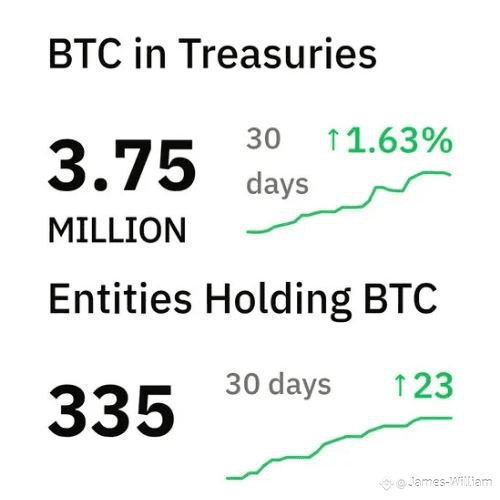The Bitcoin landscape is witnessing a notable consolidation trend. Recent on-chain data reveals that 335 entities now collectively hold approximately 3.75 million BTC, signaling an increasing concentration of Bitcoin among a relatively small number of holders. This development highlights the evolving dynamics of the cryptocurrency market, with implications for liquidity, price stability, and institutional influence.
Institutional Accumulation and Market Impact
A growing number of institutional investors, hedge funds, and crypto-focused corporations are entering the Bitcoin market. These entities—ranging from publicly traded companies to large-scale crypto funds are acquiring BTC in substantial amounts, often holding them in cold wallets for the long term. The accumulation of 3.75M BTC among 335 entities represents roughly 20% of Bitcoin’s total supply, underscoring how concentrated the market has become.

Such concentration can have dual effects. On one hand, it demonstrates confidence in Bitcoin as a store of value, potentially supporting long-term price stability. On the other hand, it raises questions about liquidity: if a significant portion of Bitcoin is locked in institutional hands, the ability for retail traders to buy or sell without impacting price could be constrained.
Key Players Driving Accumulation
While specific entities are not fully disclosed, public filings and blockchain analysis indicate that companies like MicroStrategy, Tesla, and several crypto-focused investment funds are part of this growing pool. These players are capitalizing on Bitcoin’s perceived scarcity and hedge potential against traditional financial risks. Their accumulation strategies often involve large, infrequent purchases designed to minimize market disruption while building significant exposure.
Additionally, some high-net-worth individuals and family offices are joining the ranks, further contributing to the centralization of Bitcoin holdings. This trend highlights a shift in market behavior, where long-term investors and institutions increasingly dominate supply, potentially setting the stage for more pronounced price movements during periods of high demand.
Market Implications
The growing concentration of Bitcoin raises several considerations for traders and investors:
Liquidity Risks: With a large portion of supply held by relatively few wallets, the market could experience increased volatility if any major holders decide to sell.
Price Resilience: On the flip side, long-term accumulation by institutions could act as a stabilizing force, reducing short-term fluctuations.
Market Psychology: Awareness of concentrated holdings can influence retail and institutional sentiment, as investors anticipate moves by these major players.
Analysts also note that this accumulation trend may continue, particularly as global macroeconomic uncertainties drive demand for non-sovereign assets like Bitcoin. As institutions increasingly view BTC as a hedge against inflation, the number of BTC concentrated in large wallets is likely to rise.
Looking Ahead
The data on concentrated Bitcoin holdings is a critical metric for understanding market dynamics. While the 335 entities holding 3.75M BTC represent a relatively small fraction of the total number of Bitcoin wallets, their influence on the market is substantial. Traders and investors should monitor this trend closely, as movements by these large holders can have outsized effects on price, liquidity, and overall market sentiment.

In conclusion, the growing concentration of Bitcoin among a few hundred entities underscores the evolving maturity of the market. Institutional adoption continues to reshape how Bitcoin is perceived and traded, and this shift could define the next phase of growth and stability in the crypto ecosystem.

